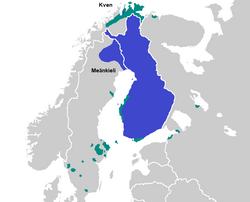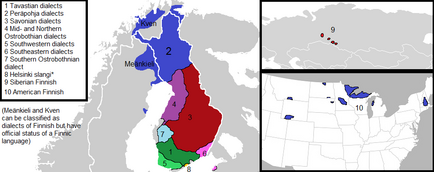اللغة الفنلندية
| Finnish | |
|---|---|
| suomen kieli | |
| النطق | IPA: [ˈsuo̯mi] ( |
| موطنها | Finland, Sweden, Norway (in small areas in Troms and Finnmark), روسيا |
| العرق | Finns |
الناطقون الأصليون | 5٫8 million Finland 5٫4 million Sweden 0٫40 million Norway 8٬000 (Kven) Karelia 8٬500 USA 26٬000 (2020)e18 |
الاورالية
| |
| Latin (Finnish alphabet) Finnish Braille | |
| Signed Finnish | |
| الوضع الرسمي | |
لغة رسمية في | قالب:Country data Nordic Council |
لغة أقلية معترف بها في | |
| ينظمها | Language Planning Department of the Institute for the Languages of Finland |
| أكواد اللغات | |
| ISO 639-2 | fin |
| ISO 639-2 | fin |
| ISO 639-3 | fin |
| Glottolog | finn1318 |
| Linguasphere | 41-AAA-a |
Majority language
Spoken by a minority | |
الفنلندية (endonym: suomi [ˈsuo̯mi] (![]() استمع) or suomen kieli [ˈsuo̯meŋ ˈkie̯li]) هي اللغة التي يكلم بها أغلبية سكان فنلندا (92%) وأفراد العرقية الفنلندية خارج فنلندا. وهي أيضاً لغة رسمية في فنلندا ولغة أقلية رسمية في السويد. Finnish is one of the two official languages of Finland (the other being Swedish). In Sweden, both Finnish and Meänkieli (which has significant mutual intelligibility with Finnish[2]) are official minority languages. The Kven language, which like Meänkieli is mutually intelligible with Finnish, is spoken in the Norwegian county Troms og Finnmark by a minority group of Finnish descent.
استمع) or suomen kieli [ˈsuo̯meŋ ˈkie̯li]) هي اللغة التي يكلم بها أغلبية سكان فنلندا (92%) وأفراد العرقية الفنلندية خارج فنلندا. وهي أيضاً لغة رسمية في فنلندا ولغة أقلية رسمية في السويد. Finnish is one of the two official languages of Finland (the other being Swedish). In Sweden, both Finnish and Meänkieli (which has significant mutual intelligibility with Finnish[2]) are official minority languages. The Kven language, which like Meänkieli is mutually intelligible with Finnish, is spoken in the Norwegian county Troms og Finnmark by a minority group of Finnish descent.
Finnish is typologically agglutinative[3] and uses almost exclusively suffixal affixation. Nouns, adjectives, pronouns, numerals and verbs are inflected depending on their role in the sentence. Sentences are normally formed with subject–verb–object word order, although the extensive use of inflection allows them to be ordered otherwise. Word order variations are often reserved for differences in information structure.[4] The orthography uses a Latin-script alphabet derived from the Swedish alphabet, and for the most part each grapheme corresponds to a single phoneme and vice versa. Vowel length and consonant length are distinguished, and there are a range of diphthongs, although vowel harmony limits which diphthongs are possible.
. . . . . . . . . . . . . . . . . . . . . . . . . . . . . . . . . . . . . . . . . . . . . . . . . . . . . . . . . . . . . . . . . . . . . . . . . . . . . . . . . . . . . . . . . . . . . . . . . . . . . . . . . . . . . . . . . . . . . . . . . . . . . . . . . . . . . . . . . . . . . . . . . . . . . . . . . . . . . . . . . . . . . . . .
التاريخ
قبل التاريخ
The Uralic family of languages, of which Finnish is a member, are hypothesized to derive from a single ancestor language termed Proto-Uralic, spoken sometime between 8,000 and 2,000 BCE (estimates vary) in the vicinity of the Ural mountains.[5] Over time, Proto-Uralic split into various daughter languages, which themselves continued to change and diverge, yielding yet more descendants. One of these descendants is the reconstructed Proto-Finnic, from which the Finnic languages developed,[6] and which diverged from Proto-Samic (a reconstructed ancestor of the Sámi languages) around 1500–1000 BCE.[7]
Medieval period

Writing system
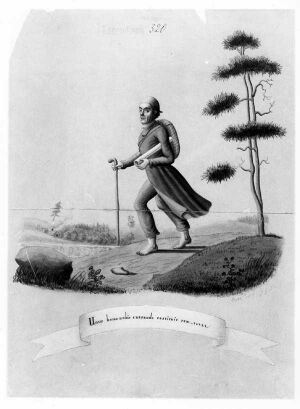
Dialects
The dialects of Finnish are divided into two distinct groups, Western and Eastern.[8] The dialects are largely mutually intelligible and are distinguished from each other by changes in vowels, diphthongs and rhythm, as well as in preferred grammatical constructions. For the most part, the dialects operate on the same phonology and grammar. There are only marginal examples of sounds or grammatical constructions specific to some dialect and not found in standard Finnish. Two examples are the voiced dental fricative found in the Rauma dialect, and the Eastern exessive case.
Lexicon
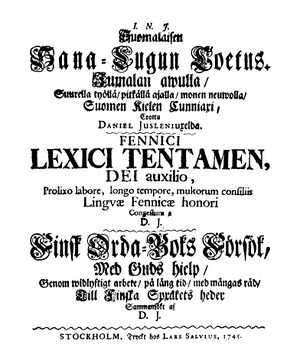
Finnish has a smaller core vocabulary than, for example, English, and uses derivational suffixes to a greater extent. As an example, take the word kirja "a book", from which one can form derivatives kirjain "a letter" (of the alphabet), kirje "a piece of correspondence, a letter", kirjasto "a library", kirjailija "an author", kirjallisuus "literature", kirjoittaa "to write", kirjoittaja "a writer", kirjuri "a scribe, a clerk", kirjallinen "in written form", kirjata "to write down, register, record", kirjasin "a font", and many others.
Here are some of the more common such suffixes. Which of each pair is used depends on the word being suffixed in accordance with the rules of vowel harmony.
| Suffix | Used to create... | Example(s) | Notes |
|---|---|---|---|
| -ja / -jä | agents from verbs | lukea "to read" → lukija "reader" | |
| -sto / -stö | collective nouns | kirja "a book" → kirjasto "a library"
laiva "a ship" → laivasto "navy, fleet" |
|
| -in | instruments or tools | kirjata "to book, to file" → kirjain "a letter" (of the alphabet)
vatkata "to whisk" → vatkain "a whisk, mixer" |
|
| -uri / -yri | agents or instruments | kaivaa "to dig" → kaivuri "an excavator"
laiva "a ship" → laivuri "shipper, shipmaster" |
|
| -os / -ös | result nouns from verbs | tulla "to come" → tulos "result, outcome"
tehdä "to do" → teos "a piece of work" |
|
| -ton / -tön | adjectives indicating the lack of something | onni "happiness" → onneton "unhappy"
koti "home" → koditon "homeless" |
|
| -kas / -käs | adjectives from nouns | itse "self" → itsekäs "selfish"
neuvo "advice" → neuvokas "resourceful" |
|
| -va / -vä | adjectives from verbs | taitaa "to be able" → taitava "skillful"
johtaa "to lead" → johtava "leading" |
|
| -llinen | adjectives from nouns | lapsi "child" → lapsellinen "childish"
kauppa "a shop, commerce" → kaupallinen "commercial" |
|
| -la / -lä | locations (places related to the stem) | kana "a hen" → kanala "a henhouse"
pappi "a priest" → pappila "a parsonage" |
|
| -lainen /
-läinen |
inhabitants (of places), among others | Englanti "England" → englantilainen "English person/thing"
Venäjä "Russia" → venäläinen "Russian person or thing". |
formed from -la / -lä plus -inen |
Verbal derivational suffixes are extremely diverse; several frequentatives and momentanes differentiating causative, volitional-unpredictable and anticausative are found, often combined with each other, often denoting indirection. For example, hypätä "to jump", hyppiä "to be jumping", hypeksiä "to be jumping wantonly", hypäyttää "to make someone jump once", hyppyyttää "to make someone jump repeatedly" (or "to boss someone around"), hyppyytyttää "to make someone to cause a third person to jump repeatedly", hyppyytellä "to, without aim, make someone jump repeatedly", hypähtää "to jump suddenly" (in anticausative meaning), hypellä "to jump around repeatedly", hypiskellä "to be jumping repeatedly and wantonly". Caritives are also used in such examples as hyppimättä "without jumping" and hyppelemättä "without jumping around". The diversity and compactness of both derivation and inflectional agglutination can be illustrated with istahtaisinkohankaan "I wonder if I should sit down for a while after all" (from istua, "to sit, to be seated"):
- istua "to sit down" (istun "I sit down")
- istahtaa "to sit down for a while"
- istahdan "I'll sit down for a while"
- istahtaisin "I would sit down for a while"
- istahtaisinko "should I sit down for a while?"
- istahtaisinkohan "I wonder if I should sit down for a while"
- istahtaisinkohankaan "I wonder if I should sit down for a while after all"
الاستعارة من اللغات الأخرى
Over the course of many centuries, the Finnish language has borrowed many words from a wide variety of languages, most from neighbouring Indo-European languages. Owing to the different grammatical, phonological and phonotactic structure of the Finnish language, loanwords from Indo-European have been assimilated.
الإعارات إلى اللغات الأخرى
The most commonly used Finnish word in English is sauna, which has also been loaned to many other languages.
Orthography
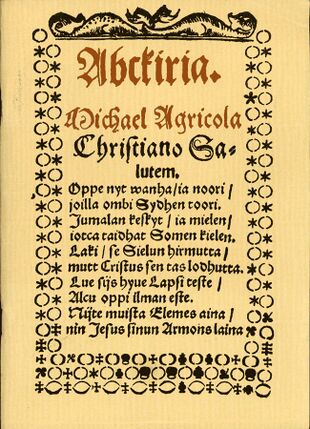
. . . . . . . . . . . . . . . . . . . . . . . . . . . . . . . . . . . . . . . . . . . . . . . . . . . . . . . . . . . . . . . . . . . . . . . . . . . . . . . . . . . . . . . . . . . . . . . . . . . . . . . . . . . . . . . . . . . . . . . . . . . . . . . . . . . . . . . . . . . . . . . . . . . . . . . . . . . . . . . . . . . . . . . .
Basic greetings and phrases
| الفنلندية | الترجمة | ملاحظات |
|---|---|---|
| Greetings | ||
| (Hyvää) huomenta! | (Good) morning! | |
| (Hyvää) päivää! | (Good) day! | used on greeting and also when taking farewell |
| (Hyvää) iltaa! | (Good) evening! | used on greeting and also when taking farewell |
| Hyvää yötä!
Öitä! |
Good night!
Night! |
|
| Terve | lit. "Health!" | Used on greeting, modified as Terve vaan! ("health continue!") |
| Moro
Hei(ppa) Moi(kka) |
Hi! / Bye! | Used on greeting and also when taking farewell |
| Moi moi!
Hei hei! |
Bye! | Used when taking farewell |
| Nähdään | See you later! | Lit. the passive form of nähdä "to see" |
| Näkemiin | Goodbye! | Lit. "Until seeing", illative of the third infinitive |
| Hyvästi | Goodbye / Farewell | |
| Hauska tutustua!
Hauska tavata! |
Nice to meet you! | Hauska tutustua is literally "nice to get acquainted", and
hauska tavata is literally "nice to meet" |
| Mitä kuuluu?
Miten menee? |
How are you?
How's it going? |
Mitä (sinulle/teille) kuuluu is literally "what (to you) is heard?" or "what concerns you?" |
| Kiitos hyvää
Kiitos hyvin |
Fine, thank you.
Well, thank you. |
Kiitos hyvää is an appropriate response to Mitä kuuluu?, whereas
Kiitos hyvin is an appropriate response to Miten menee? |
| Tervetuloa! | Welcome! | Tervetuloa is used in a broader range of contexts in Finnish than in English;
for example to mean "looking forward to seeing you" after arranging a visit |
| Important words and phrases | ||
| Anteeksi | Excuse me | |
| Kiitos
Kiitoksia |
Thanks / Please | Kiitos / kiitoksia are literally "thanks", but are also used when requesting something,
like "please" in English |
| Kiitos, samoin | Thank you, likewise | Lit. "thank you, the same way" (used as a response to well-wishing) |
| Ole hyvä | You're welcome | Lit. "be good", also used when giving someone something to mean "here you are" |
| Kyllä | Certainly / yes | |
| Joo | Yeah | More informal than kyllä |
| Ei | No / it is not | |
| Voitko auttaa? | Can you help? | |
| Apua! | Help! | |
| Totta kai!
Tietysti! Toki! |
Certainly! | |
| (Paljon) onnea | Good luck /
congratulations |
|
| Olen pahoillani | I'm sorry | |
| Odota | Wait | |
| Pieni hetki
Pikku hetki Hetkinen |
One moment | |
| Otan osaa | My condolences | |
| (Minä) ymmärrän | I understand | |
| En ymmärrä | I don't understand | |
| Suomi | Finland | |
| suomi
suomen kieli |
Finnish (language) | |
| suomalainen | (noun) Finn; (adjective) Finnish | |
See also
|
|
References
- ^ О государственной поддержке карельского, вепсского и финского языков в Республике Карелия (in الروسية). Gov.karelia.ru. Retrieved 2011-12-06.
- ^ Öst, Heidi (2013). "Recent Legal Developments in Sweden: What Effect for Finnish and Meänkieli Speakers?". European Yearbook of Minority Issues Online. 10 (1): 563–582. doi:10.1163/22116117-01001026. ISSN 1570-7865.
- ^ Haspelmath, Martin Dryer; Matthew S Gil; David Comrie; Bernard Bickel; Balthasar Nichols, Johanna (2005). Fusion of selected inflectional formatives. Oxford University Press. OCLC 945596278.
- ^ Vilkuna, Maria (1989). Free word order in Finnish : its syntax and discourse functions. Suomalaisen kirjallisuuden seura. ISBN 951-717-558-2. OCLC 997419906.
- ^ Bakro-Nagy, M. (July 2005). "The Uralic Language Family. Facts, Myths and Statistics". Lingua. 115 (7): 1053–1062. doi:10.1016/j.lingua.2004.01.008. ISSN 0024-3841.
- ^ Laakso, Johanna (2001), "The Finnic languages", Circum-Baltic Languages, Studies in Language Companion Series, 54, Amsterdam: John Benjamins Publishing Company, pp. clxxix–ccxii, doi:, ISBN 978-90-272-3057-7
- ^ Dangerous multilingualism: northern perspectives on order, purity and normality. UK: Palgrave Macmillan. 2012. p. 26. ISBN 978-0-230-32141-0.
- ^ "Suomen murteet". Archived from the original on 2007-09-27. Retrieved 2008-01-03.
Further reading
- Karlsson, Fred (2008). Finnish: An Essential Grammar. Routledge Essential Grammars (2nd ed.). United Kingdom: Routledge. ISBN 978-0-415-43914-5.
- Karlsson, Fred (2018). Finnish – A Comprehensive Grammar. London and New York: Routledge. ISBN 978-1-138-82104-0.
- Whitney, Arthur H (1973). Finnish. Teach Yourself Books. London: Hodder & Stoughton. ISBN 978-0-340-05782-7.
External links
| Find more about Finnish language at Wikipedia's sister projects | |
| Definitions from Wiktionary | |
| Media from Commons | |
| Textbooks from Wikibooks | |
| Travel guide from Wikivoyage | |
- CS1 uses الروسية-language script (ru)
- CS1 الروسية-language sources (ru)
- Short description is different from Wikidata
- Articles containing فنلندية-language text
- Languages with ISO 639-2 code
- Languages with ISO 639-1 code
- Articles with hatnote templates targeting a nonexistent page
- اللغة الفنلندية
- لغات إلصاقية
- Finnic languages
- لغات إستونيا
- لغات فنلندا
- لغات النرويج
- لغات روسيا
- لغات السويد
- Vowel-harmony languages
- Subject–verb–object languages
- لغات فنلندية مجرية
- لغات الاتحاد الأوروبي

